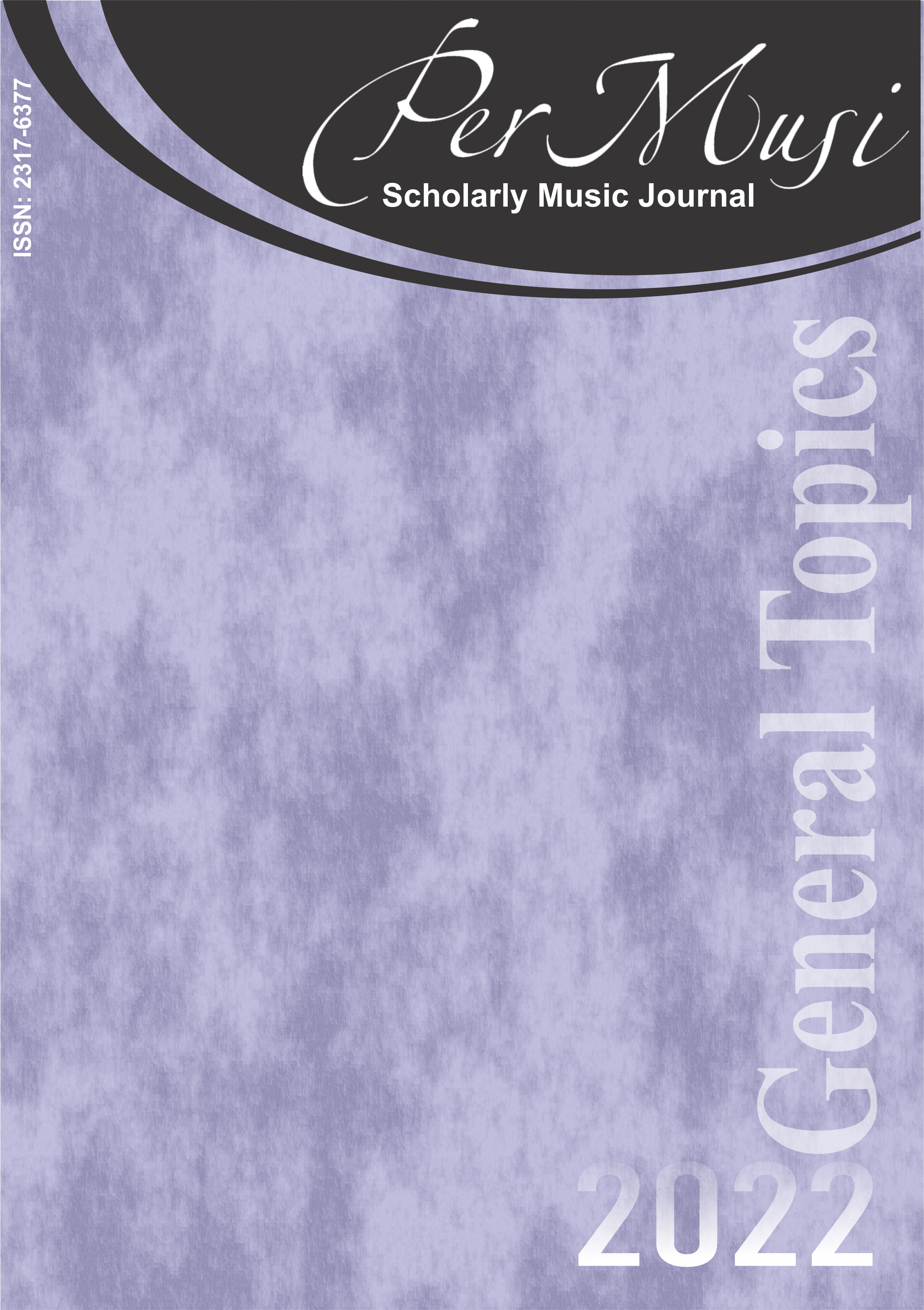O estudo do choro como ferramenta e estímulo à aprendizagem musical
DOI:
https://doi.org/10.35699/2317-6377.2022.35058Palavras-chave:
Aprendizagem musical, Choro, Improvisação, Música brasileira, Performance musicalResumo
Este artigo pretende discutir e trazer à reflexão o papel do gênero Choro na formação do músico instrumentista. Buscou-se fomentar elementos norteadores para linhas de atuações no cenário pedagógico-musical, subsidiadas pela caracterização do Choro no estudo do instrumento musical, sobretudo na performance musical e, dentro dela, a improvisação. Ressalta-se, ainda, que o gênero em questão é bastante difundido no meio musical, em que seus preceitos composicionais têm sido utilizados na formação do jovem músico aprendiz. O tema mostra outro aspecto do ensino musical: a inserção dessa música brasileira, de cunho popular, nas diretrizes acadêmicas escolares, buscando evidências plausíveis à questão da aprendizagem e do estímulo musicais.
Referências
Almada, Carlos. 2006. A estrutura do choro. Rio de Janeiro: Da Fonseca Comunicação.
Arroyo, Margarete. Educação Musical na contemporaneidade. In: II SEMINÁRIO NACIONAL DE PESQUISA EM MÚSICA DA UFG. Anais... Goiânia, 2002. Disponível em: <https://mestrado.emac.ufg.br/n/31464-sempem-anais-on-line>. Acesso em: 25 mar. 2020.
Barreto, Almir Côrtes. O estilo interpretativo de Jacob do Bandolim. Dissertação (Mestrado em Música) – Faculdade de Música do Instituto de Artes da UNICAMP, Universidade Estadual de Campinas, Campinas, 2006. Disponível em: <http://repositorio.unicamp.br/jspui/bitstream/REPOSIP/284747/1/Cortes_Almir_M.pdf>. Acesso em: 20 mar. 2020.
Bessa, Virgínia de Almeida. 2010. A escuta singular de Pixinguinha: história e música popular no Brasil dos anos 1920 e 1930. São Paulo: Alameda Casa Editorial.
Brito, Teca Alencar de. 2015. Hans-Joachim Koellreutter: músico e educador musical menor. Revista da Abem, Londrina, v. 23, n. 35, p. 11-23. Disponível em: <http://www.abemeducacaomusical.com.br/revistas/revistaabem/index.php/revistaabem/article/view/568>. Acesso em: 10 abr. 2020.
Cazes, Henrique. 2010. Choro: do quintal ao municipal. 4. ed. São Paulo: Editora 34.
Cooke, Mervyn; Horn, David. 2002. The Cambridge companion to jazz. Cambridge: Cambridge University Press.
Diniz, André. 2003. Almanaque do choro: a história do chorinho, o que ouvir, o que ler, onde curtir. Rio de Janeiro: Jorge Zahar Editor.
Hallam, Susan. 2006. Music psychology in education. London: Institute of Education, University of London.
Kuehn, Frank Michael Carlos. 2012. Interpretação – reprodução musical – teoria da performance: reunindo-se os elementos para uma reformulação conceitual da(s) prática(s) interpretativa(s). Per Musi. Belo Horizonte, n. 26, online. Disponível em: <http://www.scielo.br/scielo.php?pid=S1517-75992012000200002&script=sci_arttext>. Acesso em: 5 mar. 2020.
Lara Filho, I. G.; Silva, G. T. da; Freire, R. D. 2011. Análise do contexto da Roda de Choro com base no conceito de ordem musical de John Blacking. Per Musi. Belo Horizonte, n. 23, p. 148- 161. Disponível em: <http://www.scielo.br/pdf/pm/n23/n23a16.pdf>. Acesso em: 01 mar. 2020.
Magalhães, Alexandre Caldi. Contracantos de Pixinguinha: contribuições históricas e analíticas para a caracterização do estilo. 2001. Dissertação (Mestrado em Música) – Instituto Villa-Lobos, Centro de Letras e Artes, Universidade Federal do Estado no Rio de Janeiro, Rio de Janeiro, 2001.
Mendonça, Ocelo. O violoncelo entre o choro e a improvisação: novos desafios interpretativos na prática do instrumentista em formação tradicional. 2006. Dissertação (Mestrado em Música) – Instituto Villa-Lobos, Centro de Letras e Artes, Universidade Federal do Estado no Rio de Janeiro, Rio de Janeiro, 2006.
Paz, Ermelinda A. 2013. Pedagogia musical brasileira no século XX. Metodologias e tendências. 2. ed. Brasília: MusiMed.
Rink, John. 2002. Musical performance: a guide to understanding. London: Cambridge University Press.
Sadie, Stanley (Ed.). 1994. Dicionário Grove de Música: edição concisa. Rio de Janeiro: Jorge Zahar Ed.
Salek, Eliane Corrêa. A flexibilidade rítmico-melódica na interpretação do choro. 1999. Dissertação (Mestrado em Música) – Instituto Villa-Lobos, Centro de Letras e Artes, Universidade Federal do Estado do Rio de Janeiro, Rio de Janeiro, 1999.
Sève, Mário. 1999. Vocabulário do choro: estudos e composições. 3. ed. Rio de Janeiro: Lumiar.
Valente, Paula Veneziano. Horizonte e verticalidade: dois modelos de improvisação no choro brasileiro. 2009. Dissertação (Mestrado em Música) – Escola de Comunicação e Arte da Universidade de São Paulo, São Paulo, 2009. Disponível em: <http://www.teses.usp.br/teses/disponiveis/27/27158/tde-25102010-170951/pt-br.php>. Acesso em: 04 mar. 2020.
Publicado
Edição
Seção
Licença
Copyright (c) 2022 Per Musi

Este trabalho está licenciado sob uma licença Creative Commons Attribution 4.0 International License.

Exceto onde está indicado, o conteúdo neste site está sob uma Licença Creative Commons - Atribuição 4.0 Internacional.












